Italian authorities have dismantled an international network of art forgers responsible for creating and selling counterfeit works by some of the world’s most famous artists, including Andy Warhol, Banksy, and Pablo Picasso.
The operation, which spanned multiple countries, led to the investigation of 38 people, including six suspects from Spain, France, and Belgium.
The Italian Ministry of Culture announced on Monday that they, alongside the authorities of the three other European countries, had seized more than 2,100 forged artworks, attributed to over 30 renowned artists.
It is estimated that the network’s fraudulent activities could have caused economic damage exceeding $212 million by flooding the art market with fake paintings.

Fake modern and contemporary artworks that were sized by police are show in Rome, Nov. 11, 2024. Thirty-eight people have been placed under investigation in relation to the forgeries, including six in Spain, France and Belgium.
Italian Culture Ministry, HOGP/AP
Why Were Worhols and Banksys Forged?
Among the counterfeit works were pieces supposedly created by iconic figures including Amedeo Modigliani, Joan Miró, Francis Bacon, Wassily Kandinsky, Henry Moore, and Gustav Klimt.
They were presented as genuine paintings, complete with forged certificates of authenticity, some of which were issued by complicit auction houses in Italy.
According to Eurojust, the European Union agency responsible for judicial cooperation, the investigation revealed a complex network of forgers who were behind the production of the pieces.
Warhols and Banksys were reportedly among the most commonly forged artworks.
The forgeries were displayed at art shows in Italy, including exhibitions in Mestre and Cortona, where catalogs featuring the fakes were distributed to potential buyers.




Fake modern and contemporary artworks that were sized by police are show in Rome, Oct. 15, 2024. Italian authorities say the network could have done 200 million euros in economic damage by flooding the art market with fake works.
Italian Culture Ministry, HOGP/AP
How Wide Was the Fake Art Network?
The investigation began in March 2023, when Italian authorities discovered 200 counterfeit artworks while they were searching the home of a business owner in Pisa.
The discovery prompted them to expand their efforts by monitoring e-commerce platforms and auction house sites for further evidence of fraudulent activity.
They later seized around 500 forged certificates and stamps of authenticity, which were used to legitimize the fake artworks.
The investigation has led to a series of arrests, with the suspects facing charges of conspiracy to forge and trade in contemporary art.
Sophisticated International Art Forgery Trade
Eurojust said the network exploited the credibility of established auction houses to sell the forgeries to unsuspecting buyers, creating a significant challenge for the art market.
The operation marks a significant blow to the international art forgery trade, which has become increasingly sophisticated in recent years.
As the art market continues to grow, the ability to authenticate works has become a key concern for collectors, galleries, and auction houses alike.
With the involvement of multiple countries in this investigation, authorities are hopeful that the dismantling of this network will serve as a deterrent to other would-be forgers in the future.
This article contains additional reporting from The Associated Press
This post was originally published on this site be sure to check out more of their content



